Miso Udon Noodle Soup has become my go-to comfort food, especially on chilly evenings. I remember the first time I tasted it; the rich, savory broth filled my senses with the umami notes of miso paste and the satisfying chew of thick udon noodles. This Japanese-inspired dish is surprisingly simple to whip up, making it a perfect weeknight meal. It’s an easy vegetarian recipe that feels both hearty and nourishing. The aroma alone is enough to make your stomach rumble! Let’s get cooking and bring this bowl of deliciousness into your home!
Why You’ll Love This Miso Udon Noodle Soup
This recipe for Miso Udon Noodle Soup is a winner for so many reasons. It’s incredibly comforting, perfect for those nights when you just need a warm hug in a bowl. You’ll adore the deep, savory flavor that comes from the miso broth, balanced beautifully with the sweet teriyaki mushrooms. As an easy miso udon soup, it comes together in a flash, making it ideal for busy weeknights. It’s a nourishing and satisfying meal that’s naturally vegetarian-friendly.
- Incredibly comforting and warming
- Rich, savory flavor profile
- A quick meal, ready in about 30 minutes
- Nourishing and satisfying
- Completely vegetarian-friendly
- Highly customizable to your taste
- An easy miso udon soup for any skill level
- Packed with delicious umami notes
Miso Udon Noodle Soup Ingredients
Gathering the right miso udon noodle soup ingredients is key to achieving that authentic Japanese flavor. For the teriyaki mushrooms, you’ll need 2 cups sliced mushrooms (shiitake or oyster are fantastic here), 1 tbsp oil for sautéing, 2 tbsp soy sauce, 1 tbsp mirin, 1 tbsp maple syrup, 1 tsp sesame oil, and 1 tsp cornstarch mixed with 1 tbsp water to thicken the glaze. For the heart of our dish, the miso broth, we’ll use 3 cups vegetable broth, 1½ tbsp miso paste (white or yellow for a milder taste is perfect for this udon noodle soup with miso paste), another 1 tsp soy sauce, 1 tsp sesame oil, ½ tsp grated ginger, and 1 minced garlic clove. Finally, for assembly, grab 2 servings udon noodles (fresh or frozen for that signature chewy texture), ½ cup tofu (pan-fried or air-fried), and 1 cup bok choy or spinach. Don’t forget optional garnishes like scallions, sesame seeds, and chili oil!
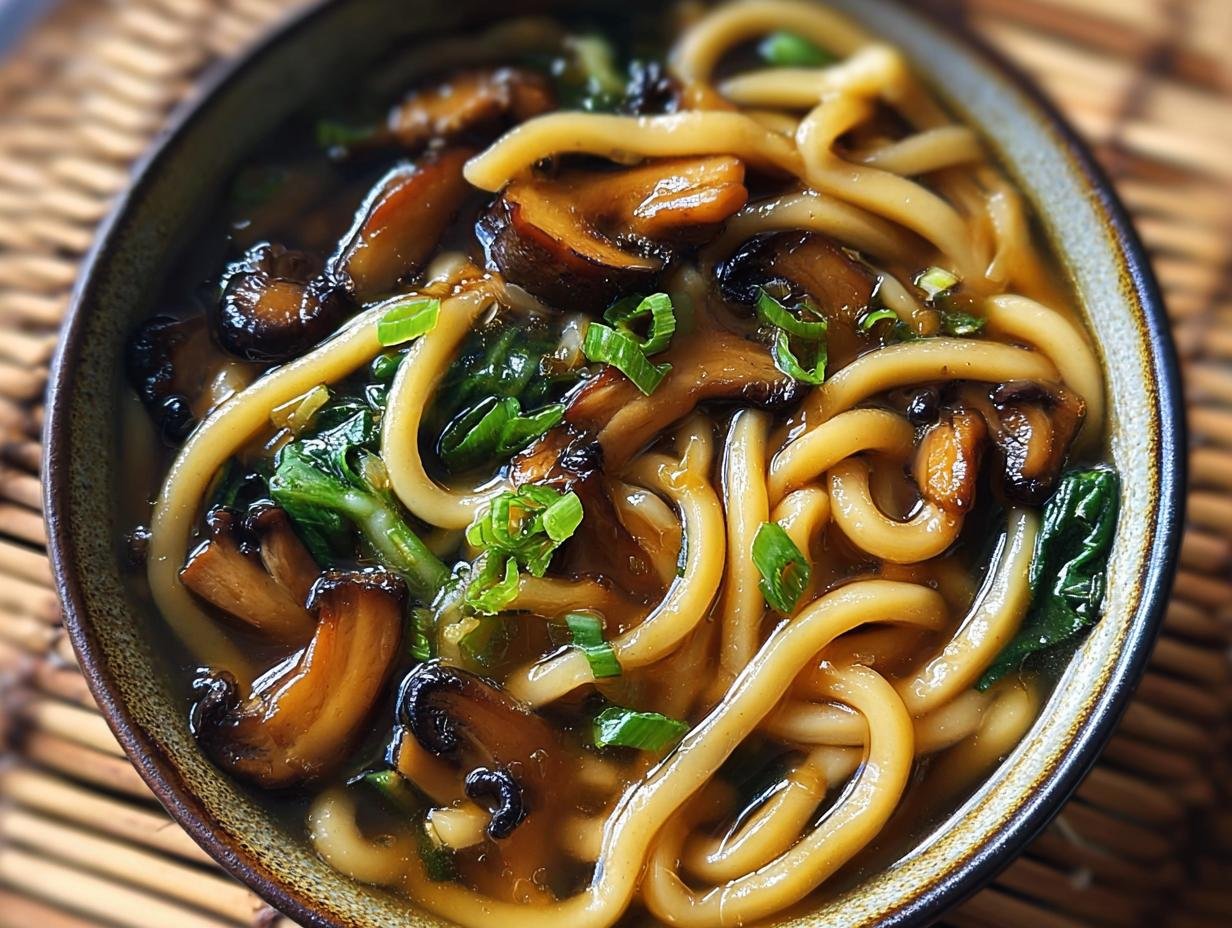
How to Make Miso Udon Noodle Soup
Follow these simple steps to create a bowl of comfort. This guide will show you exactly how to make miso udon noodles that are both delicious and satisfying, proving that a quick miso udon noodle soup can be incredibly flavorful.
Step 1: Prepare the Teriyaki Mushrooms
Start by heating 1 tbsp oil in a pan over medium-high heat. Add your 2 cups sliced mushrooms and sauté until they are beautifully browned and slightly tender. While they cook, whisk together 2 tbsp soy sauce, 1 tbsp mirin, 1 tbsp maple syrup, and 1 tsp sesame oil in a small bowl. Stir in the 1 tsp cornstarch mixed with 1 tbsp water. Pour this mixture over the mushrooms and simmer until the sauce thickens and coats them perfectly.
Step 2: Make the Miso Broth
In a separate small pot, combine 3 cups vegetable broth, 1 tsp soy sauce, 1 tsp sesame oil, ½ tsp grated ginger, and 1 minced garlic clove. Bring this mixture to a gentle simmer over medium heat. Once simmering, reduce the heat to low. Now, add 1½ tbsp miso paste and whisk until it’s fully dissolved into the broth. Remember, never boil miso directly, as this can diminish its delicate flavor and beneficial properties. This creates the perfect base for your miso broth udon noodles.
Step 3: Cook the Udon Noodles
Boil your 2 servings udon noodles in a separate pot according to the package directions, which usually only takes about 2–3 minutes for fresh or frozen varieties. Once cooked to your liking, drain them well and rinse them briefly under warm water. This rinsing helps remove excess starch, preventing them from clumping together.
Step 4: Assemble the Bowls
Now for the fun part! Divide the cooked udon noodles between your serving bowls. Arrange the 1 cup bok choy or spinach and the ½ cup tofu (whether pan-fried or air-fried) over the noodles. Ladle the hot, savory miso broth generously over everything. Finally, top your amazing bowls with the sweet and savory teriyaki mushrooms. Add optional garnishes like chopped scallions, a sprinkle of sesame seeds, or a drizzle of chili oil for a little kick. Enjoy your quick miso udon noodle soup!
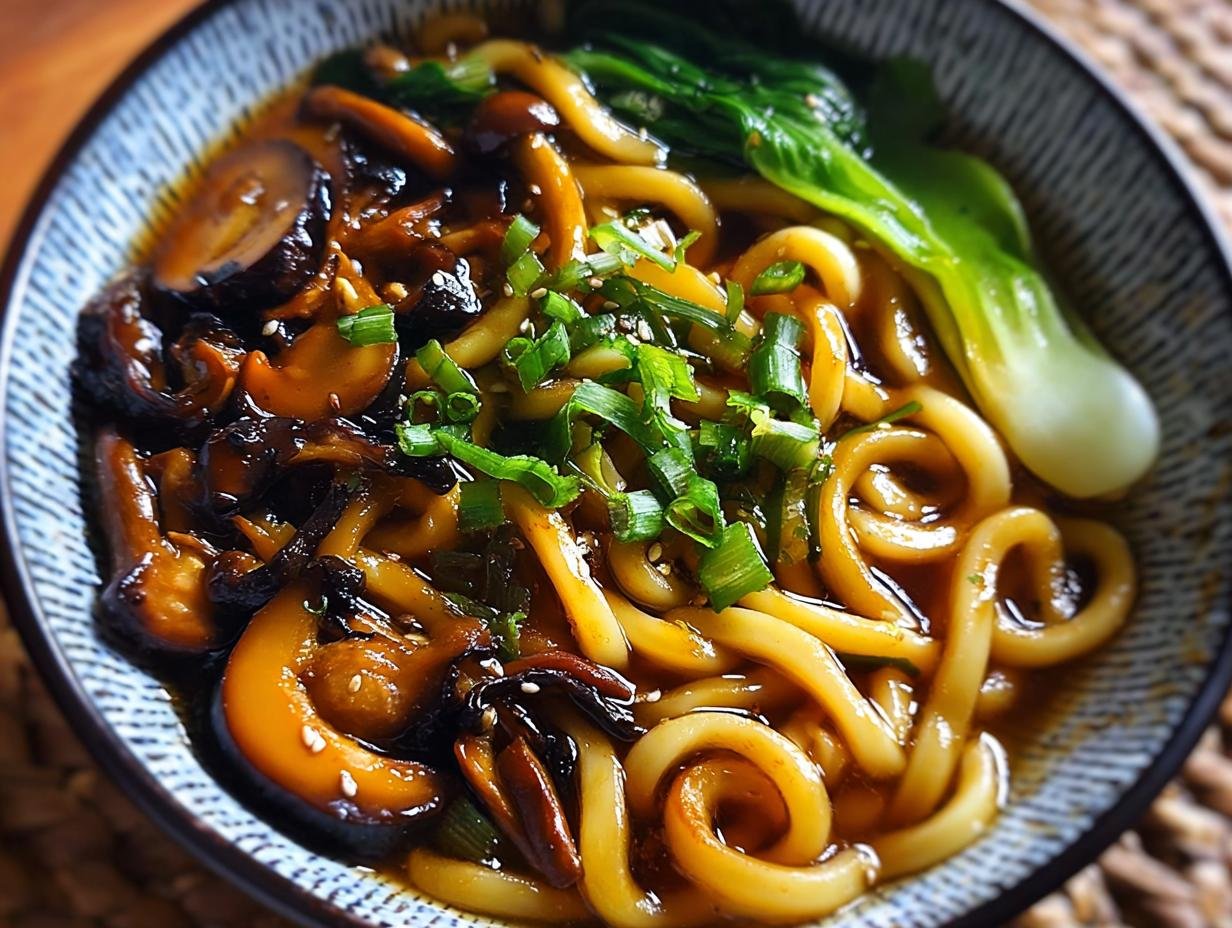
Pro Tips for the Best Miso Udon Noodle Soup
Want to elevate your comfort food game? Here are a few tricks I’ve learned to make the absolute best miso udon soup. Always opt for good quality miso paste; it truly makes a difference in the depth of flavor. Don’t be afraid to experiment with different types of mushrooms for the teriyaki topping – oyster mushrooms offer a fantastic texture!
- Use fresh or frozen udon noodles for the best chewy texture.
- Taste and adjust seasoning before serving; miso paste can vary in saltiness.
- Consider adding a splash of rice vinegar to the broth for a touch of brightness.
What’s the secret to perfect Miso Udon Noodle Soup?
The biggest secret to an authentic miso udon noodle soup is to never boil the miso paste. Always dissolve it into the broth off the heat. This preserves its delicate flavor and beneficial probiotics, ensuring a truly delicious and healthy bowl. For more on preserving food integrity, check out these sustainable farming practices.
Can I make Miso Udon Noodle Soup ahead of time?
Yes, you can! For meal prep, store the cooked udon noodles and the miso broth separately in airtight containers in the refrigerator. Reheat the broth gently and cook the noodles just before serving to prevent them from becoming mushy.
How do I avoid common mistakes with Miso Udon Noodle Soup?
The most common mistake is boiling the miso, which ruins its flavor. Another pitfall is overcooking the udon noodles; they should be cooked just until tender. Also, be mindful of the saltiness of your miso paste and adjust other salty ingredients like soy sauce accordingly. For tips on managing ingredients, you might find information on the many benefits of onions helpful.
Best Ways to Serve Miso Udon Noodle Soup
This hearty and savory miso udon soup is a complete meal on its own, but it also pairs wonderfully with a few other Japanese delights. For a light yet satisfying meal, consider serving it alongside a crisp, simple green salad with a ginger-sesame dressing. If you’re looking for something a bit more substantial, a few pan-fried gyoza or some crispy vegetable tempura make excellent companions. Don’t forget those optional garnishes! A drizzle of chili oil can transform your bowl into a delightful spicy miso udon noodle soup, perfect for those who love a little heat. You might also enjoy a refreshing blood orange mimosa with this dish.
Nutrition Facts for Miso Udon Noodle Soup
This Miso Udon Noodle Soup is a delicious and relatively healthy choice for a satisfying meal. Here’s a breakdown of the approximate nutritional information per serving, keeping in mind that exact values can vary based on the specific ingredients and brands you use.
- Calories: 360
- Fat: 12g
- Saturated Fat: 2g
- Protein: 15g
- Carbohydrates: 55g
- Fiber: 5g
- Sugar: 8g
- Sodium: 950mg
Nutritional values are estimates and may vary based on specific ingredients used.
How to Store and Reheat Miso Udon Noodle Soup
Leftover miso udon noodle soup is a treat, and knowing how to store and reheat it properly ensures you can enjoy this comforting dish later. Once your soup has cooled completely, transfer the components into airtight containers. I like to keep the noodles, broth, and toppings separate if possible, especially if you plan to store them for more than a day. This helps maintain the best texture. Refrigerated, your miso udon noodle soup should stay fresh for about 3 to 4 days. If you want to keep it even longer, freezing is a great option; it can last in the freezer for up to 3 months. Just be sure to package it well to prevent freezer burn.
Reheating is super simple! Gently warm the miso broth on the stovetop over low heat, making sure not to let it boil. If the broth seems too thick, you can add a splash of water or vegetable broth. Reheat the cooked udon noodles separately in a pot of boiling water for just a minute or two until pliable, or add them directly to the warming broth. Assemble your bowl with the reheated noodles, broth, and any desired toppings like mushrooms and tofu. It’s a fantastic way to enjoy a delicious, homemade meal even on the busiest days! For more meal prep ideas, consider easy avocado toast.
Frequently Asked Questions About Miso Udon Noodle Soup
What is miso udon soup?
Miso udon soup is a comforting Japanese noodle dish featuring thick, chewy udon noodles served in a flavorful broth made with miso paste. It’s a staple in Japanese cuisine, known for its savory, umami-rich taste that’s both deeply satisfying and surprisingly light. This dish is often customized with various toppings and ingredients, making each bowl a unique experience.
Is this a vegetarian miso udon soup?
Yes, absolutely! This recipe is designed as a delicious vegetarian miso udon soup. We use vegetable broth as the base and focus on plant-based ingredients like tofu and savory teriyaki mushrooms. You can easily make it vegan by ensuring your miso paste is vegan and using maple syrup instead of any potential honey in other recipes.
Can I make this a healthy miso udon noodle soup?
This is already a quite healthy miso udon noodle soup thanks to the wholesome ingredients! Udon noodles provide carbohydrates for energy, miso paste is known for its probiotic benefits, and we’re loading it up with vegetables and protein from tofu. To boost the health factor even further, load up on extra greens like spinach or bok choy, and go light on any added sugars or sodium in your garnishes. For more on healthy eating, explore the joy of vegetable gardening.
What are the best toppings for miso udon noodle soup?
The possibilities are endless! The recipe includes delicious teriyaki-glazed mushrooms and tofu, which are fantastic. Other popular toppings include sliced scallions, a sprinkle of toasted sesame seeds, a swirl of chili oil for a spicy kick, nori strips for extra oceanic flavor, or even a soft-boiled egg if you’re not keeping it strictly vegetarian. Experimenting with toppings is part of the fun!
Variations of Miso Udon Noodle Soup You Can Try
While this recipe is a fantastic vegetarian option, the beauty of a Japanese miso udon soup lies in its versatility. You can easily adapt it to suit your dietary needs or flavor preferences. For a heartier meal, consider adding cooked chicken or pork. A chicken miso udon noodle soup is delicious, or you could try a recipe featuring tender slices of pork for a rich variation. If you’re aiming for a completely plant-based approach, this recipe is already very close to a vegan miso udon noodle soup; just ensure your miso paste is vegan and skip any non-vegan garnishes.
You can also play with the broth itself. A dash of chili paste or a drizzle of chili oil can transform your bowl into a delightful spicy miso udon noodle soup. For a different flavor profile, try a pork miso udon soup recipe, using a pork-based broth or adding some savory pork belly. Experimenting with different types of miso, like red miso for a deeper flavor, can also create unique bowls of this comforting soup.
PrintMiso Udon Noodle Soup: 30-Min Comfort You’ll Adore
A comforting and flavorful Japanese-inspired Miso Udon Noodle Soup featuring chewy udon noodles in a savory miso broth, topped with sweet and savory teriyaki-glazed mushrooms. This easy vegetarian recipe is perfect for a quick and nourishing meal.
- Prep Time: 10 minutes
- Cook Time: 20 minutes
- Total Time: 30 minutes
- Yield: 2 servings 1x
- Category: Soup
- Method: Stovetop
- Cuisine: Japanese
- Diet: Vegetarian
Ingredients
- For the Teriyaki Mushrooms:
- 1 tbsp oil
- 2 cups sliced mushrooms (shiitake or oyster preferred)
- 2 tbsp soy sauce
- 1 tbsp mirin
- 1 tbsp maple syrup or sugar
- 1 tsp sesame oil
- 1 tsp cornstarch (mixed with 1 tbsp water)
- For the Miso Broth:
- 3 cups vegetable broth
- 1½ tbsp miso paste (white or yellow for milder flavor)
- 1 tsp soy sauce
- 1 tsp sesame oil
- ½ tsp grated ginger
- 1 garlic clove, minced
- For the Bowl:
- 2 servings udon noodles (fresh or frozen)
- ½ cup tofu (pan-fried or air-fried)
- 1 cup bok choy or spinach
- Scallions, sesame seeds, and chili oil (optional for garnish)
Instructions
- Prepare the Teriyaki Mushrooms: Heat oil in a pan. Add mushrooms and sauté until browned. In a bowl, whisk together soy sauce, mirin, maple syrup, sesame oil, and cornstarch slurry. Pour into the pan and stir. Let it simmer until the sauce thickens and coats the mushrooms.
- Make the Miso Broth: In a small pot, combine vegetable broth, soy sauce, sesame oil, ginger, and garlic. Bring to a gentle simmer. Lower the heat, add miso paste, and whisk well until fully dissolved. Never boil miso directly, as it can kill the healthy bacteria and dull the flavor.
- Cook the Udon Noodles: Boil the noodles separately according to package instructions (typically 2–3 minutes for fresh or frozen udon). Drain and rinse under warm water to remove excess starch.
- Assemble the Bowls: In each serving bowl, place noodles at the base. Add bok choy or spinach, tofu cubes, and ladle hot miso broth over the top. Finish with the glazed teriyaki mushrooms and garnish with scallions, sesame seeds, or a drizzle of chili oil for some heat.
Notes
- Always dissolve miso off the heat to preserve flavor and probiotics.
- Store noodles and broth separately if prepping ahead.
- Top with sesame seeds, chili oil, or nori strips for extra flavor.
- Use gluten-free noodles and tamari for a GF option.
Nutrition
- Serving Size: 1 bowl
- Calories: 360
- Sugar: 8g
- Sodium: 950mg
- Fat: 12g
- Saturated Fat: 2g
- Unsaturated Fat: 8g
- Trans Fat: 0g
- Carbohydrates: 55g
- Fiber: 5g
- Protein: 15g
- Cholesterol: 0mg

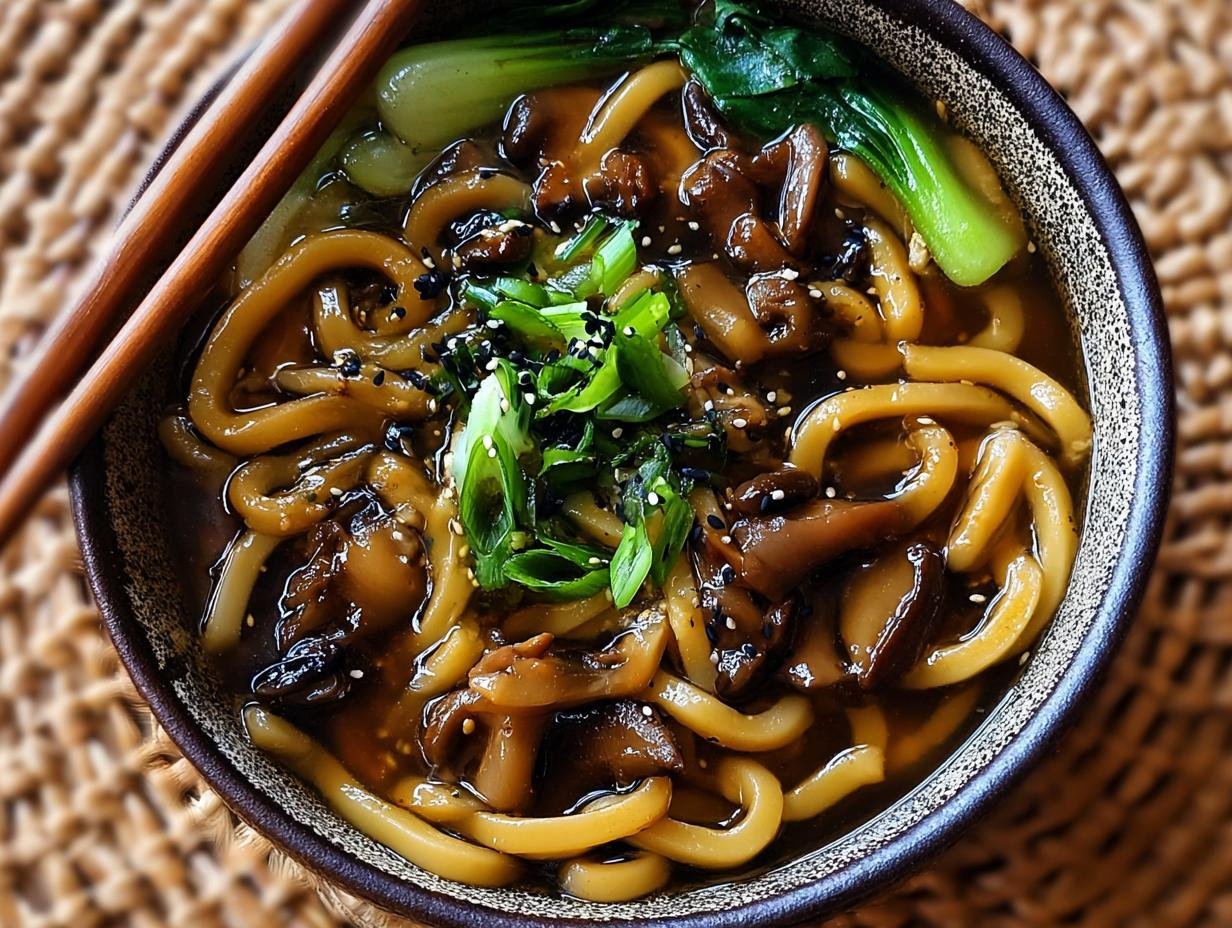
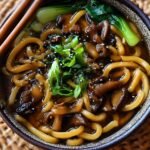






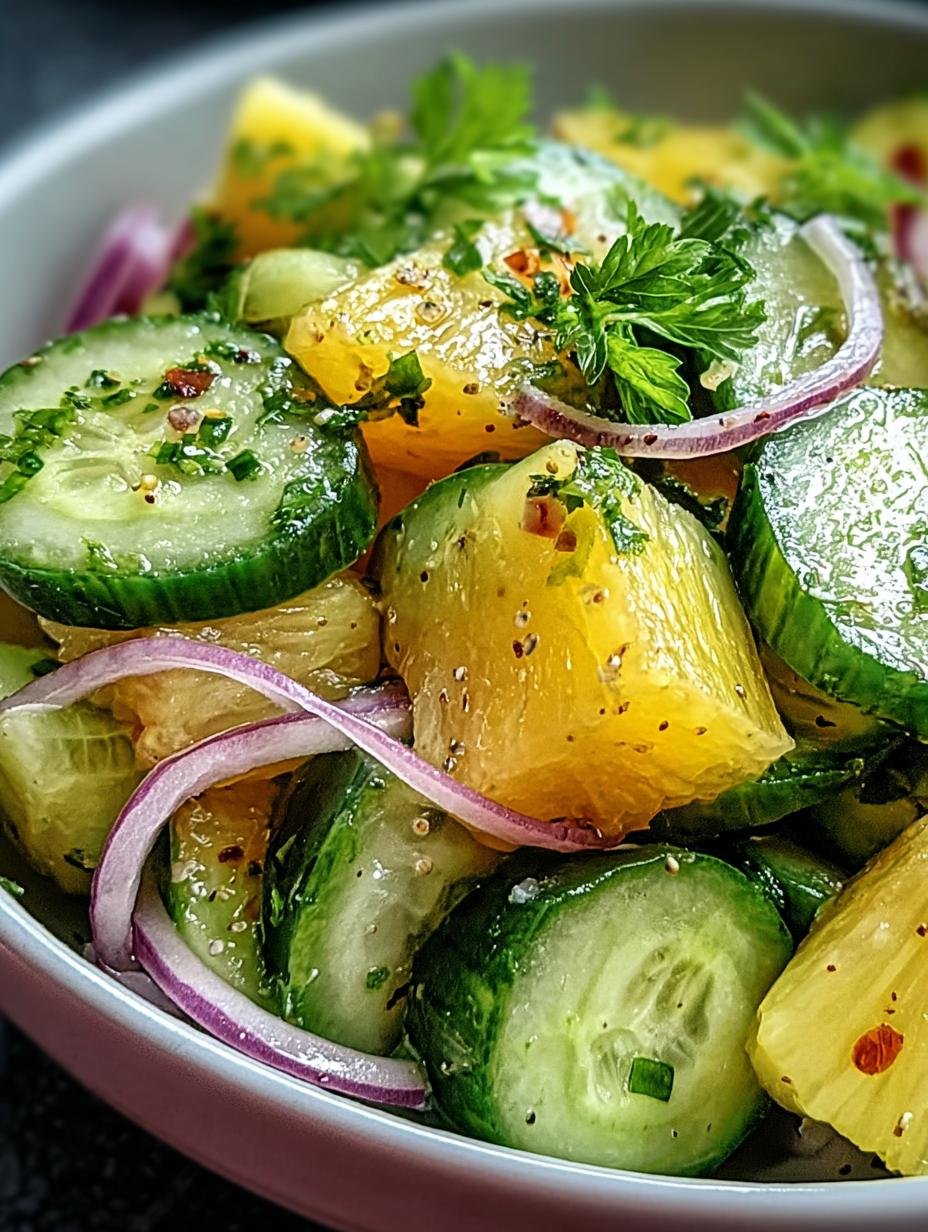



Leave a Reply